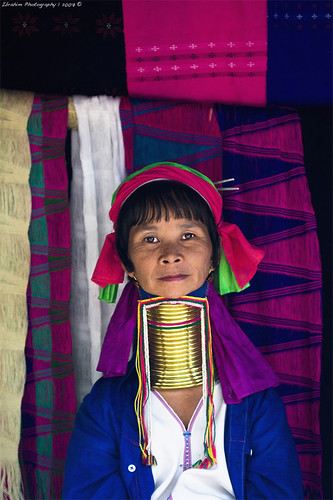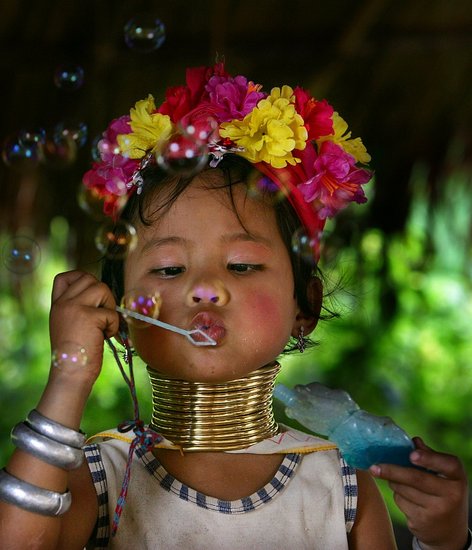

When I was younger, I came across the Kayan tribe while watching television with my older brother. I was immediately drawn to the women and their neck rings. The Kayan are originally from Burma but are now living as refugees in Thailand due to a 58 year long civil war (Parry 1). The Kayan see the neck rings as a sign of beauty and tribal identification. Even though people refer to the Kayan women’s neck decoration as neck rings it is actually a single brass coil that is wrapped around their neck. According to the article “Kayan ‘Giraffe Women’ trapped in Thailand by tourist trade”, “from the age of 5, they wrap their necks with tall coils of brass that are extended as they grow into adulthood” (Parry 1). This creates the appearance of a long neck but when in fact it is “an optical illusion; as the coils are added they push the collar bone and ribs down, creating the appearance of a longer neck” (Parry1). The women also wear brass coils on their wrists and below their knees. There is a common misconception that the women will die if the neck rings are removed. When, in fact, according to Mawe, a member of the Kayan, said, “When you take off the brass, you’re a little dizzy, and for one or two or three minutes you shouldn’t walk you feel very light and you have a headache, like you’ve been wearing a heavy backpack and you suddenly take it off” (Mydans 2). The women are not limited by the neck rings to do certain activities. For example, the girls play volleyball (Mydans 1). I found this most impressive since I play volleyball and it is a very fast moving game, and to be able to play with coils around your neck is amazing to me. Unfortunately, due to the coils the women wear around their necks, it has sealed their fate as a tourist attraction. The Thai government has been using the Kayans as a source of income. According to the article “Burmese women in Thai ‘human zoo’” by Andrew Harding, “the United Nations refugee agency (UNHCR) says that for the past two years, the Thai authorities have refused to allow a group of 20 Kayan to leave the country, despite firm offers to resettle them in Finland and New Zealand” ( 1). This has led to the younger generation of girls to take off their rings in order to further their education and to relocate. This is not an easy decision for girls to make because they put a lot at stake. For example, a girl named Zember who cast off her coil to better her life, in turn, has hurt her family because they no longer receive payments for her wearing her coils (Meo 1). In addition, the elders disagree with what some of the younger generation are doing because they feel that they are leaving their heritage behind. Even though the neck rings are a cultural modification, it has led to the objectification of the tribe and it is not respected among the tourists but rather as amusement to look at something different. The Kayan live under a state of fear because they can not leave Thailand because they bring money to the country, but they can not go home either, due to the civil war still going on. Their cultural body modification has trapped them in a state of fear and symbolic violence. They have no choice but to accept the life as a tourist attraction or possibly lose face and money for their family.
Works cited
Harding, Andrew. “Burmese Women in Thai ‘human zoo’” BBC News
http://news.bbc.co.uk/2/hi/asia-pacific/7215182.stm
Meo, Nick. “ The ‘Giraffe Women’ who cast off their brass coils” The Times Nov.4, 2006
http://www.timesonline.co.uk/tol/news/world/asia/article1086766.ece
Mydans, Seth. “Nai Soi’s Long-Necked Women” published May 20, 2001
http://query.nytimes.com/gst/fullpage.html?res=9E0DEFDC173AF933A15756C0A9679C8B63&sec=&spon=&pagewanted=2
Parry, Richard Lloyd. “Kayan ‘Giraffe Women’ trapped in Thailand by tourist trade” The Times April 2, 2008
http://www.timesonline.co.uk/tol/news/world/asia/article3701576.ece
Works cited
Harding, Andrew. “Burmese Women in Thai ‘human zoo’” BBC News
http://news.bbc.co.uk/2/hi/asia-pacific/7215182.stm
Meo, Nick. “ The ‘Giraffe Women’ who cast off their brass coils” The Times Nov.4, 2006
http://www.timesonline.co.uk/tol/news/world/asia/article1086766.ece
Mydans, Seth. “Nai Soi’s Long-Necked Women” published May 20, 2001
http://query.nytimes.com/gst/fullpage.html?res=9E0DEFDC173AF933A15756C0A9679C8B63&sec=&spon=&pagewanted=2
Parry, Richard Lloyd. “Kayan ‘Giraffe Women’ trapped in Thailand by tourist trade” The Times April 2, 2008
http://www.timesonline.co.uk/tol/news/world/asia/article3701576.ece
No comments:
Post a Comment